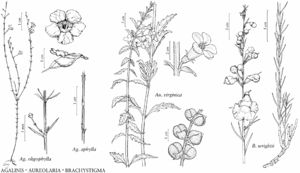Agalinis oligophylla
Bull. Torrey Bot. Club 40: 432. 1913.
Stems simple or branched, 30–90(–110) cm; branches spreading-ascending, quadrangular, with siliceous ridges on angles, scabridulous. Leaves ascending; blade subulate, elliptic, or filiform, (1–)4–13 x 0.3–1.1 mm, margins entire, heavily siliceous, scabridulous, adaxial surface siliceous, scabridulous; axillary fascicles absent. Inflorescences racemiform-paniculate, with short multinoded floriferous branches, some with pseudoterminal flowers, flowers 1 or 2 per node; bracts shorter than or sometimes equal to pedicels. Pedicels ascending, 4–16 mm, +/- scabridulous. Flowers: calyx campanulate to funnelform, tube 2.5–3.2 mm, glabrous, lobes subulate to triangular-subulate, 0.1–1 mm; corolla pink to dark pink, with 2 yellow lines and red spots in abaxial throat, 15–25 mm, throat pilose externally and villous within across bases and sinus of adaxial lobes, lobes: abaxial spreading, adaxial reflexed-spreading, 4–7(–9) mm, glabrous externally; proximal anthers parallel to filaments, distal oblique or perpendicular to filaments, pollen sacs 1.8–2.6 mm; style exserted, 6–11 mm. Capsules globular, 4–6 mm. Seeds tan to yellow, 0.5–0.9 mm. 2n = 26.
Phenology: Flowering late Sep–mid Nov.
Habitat: Moist to dry longleaf pine savannas, edges of pine plantations, dry roadsides, chalky outcrops, seepage slopes of clay roadsides.
Elevation: 0–300 m.
Distribution
Ala., Ark., La., Miss., Tenn., Tex.
Discussion
Plants of Agalinis oligophylla are rare in the easternmost portions of the range; they are abundant farther west into Texas. Agalinis oligophylla is often the last species of Agalinis to begin flowering, usually in late September, sometimes not until mid October and often remains in flower well into November. Unbranched plants of A. oligophylla can be confused with A. aphylla, with which it often shares the habitat. Agalinis oligophylla can be distinguished from A. aphylla by the longer leaves, more diffusely branched inflorescence, glabrous style, and the much later flowering period of A. oligophylla. Also, on the older buds of A. oligophylla the corolla is globular, but in A. aphylla the corolla on older buds is obovoid. Corollas of A. oligophylla are asymmetric; the adaxial side of the corolla throat is conspicuously shorter than the upcurved abaxial side of the corolla. The buds, pedicels, and capsules of A. oligophylla turn dark brown or blackish, and corollas turn dark purplish or pinkish brown when dried. These dark structures contrast strikingly with the pale green to gray (or reddish) branches and leaves.
Selected References
None.
